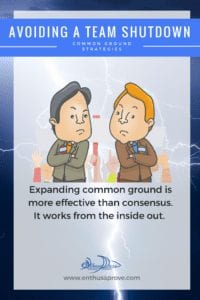
Is your team on the brink of a “shutdown?”
As a patriotic American, I am personally saddened and embarrassed by the recent government shutdown. I wonder what our friends (and enemies) in other countries think when they see the world’s most powerful country brought to a standstill by a group of highly educated and popularly elected officials come to a divisive stalemate in concerns over where to put our funding. These are not war or peace decisions, these are not slavery or free decisions…these are actually fairly small decisions that end up being more theatrical than substantive.
But the question that begs to be asked is… Do we find sadly similar situations on our own teams? Do we as team leaders feel like we are ironing out a schoolyard argument that’s escalated to name-calling brawl? How often is clinging to our own choices making it even hard to be a team leader or facilitate a dialogue?
We have all heard of consensus, and we all know that that definition is not a unanimous decision but rather a decision that we can all agree to support. Many times, consensus is a victory when the team divisiveness has reached boiling conditions. We have lots of tools for consensus but I find that most of them dwell on what I would call the outlying points of disagreement and whether we can ‘live with those.’ While this is a worthy approach, it is a bittersweet approach, and, in my experience, is not a joyful approach.
Stop with Consensus and Use Common Ground
What I would like to remind us of is the concept of finding common ground. This is not the same as consensus; it is fundamentally different. For truly eloquent discourse on this topic, my go to author is Peter Block. So, eloquence aside, here’s my quick and easy way to move your team from getting to consensus to finding and expanding common ground.
In consensus, the usual tactic is to take what I would call the outlying points of disagreement and to see if the owner is willing to either 1) accept someone else’s outlier or 2) acknowledge that they can live without their outlier. Since these outliers stand out, they frequently become lightning issues…they catch our attention and spark argument.

Expanding common ground is more effective than consensus. It works from the inside out. Face it, we are all on the same team, so we know that there is probably a trove of common ground topics/issues/values/agendas. The funny thing is that the common ground is so big it’s taken for granted and becomes almost invisible. That’s why I used the symbol of a sun…Sunny days rarely make the news, lightning storms nearly always do. Yet the sun is the source of energy for life on the planet and the reason our planet stays in its orbit. Energy and connection. That’s what these common ground topics/issues/values/agendas will give us, give our team. So, let’s work from those out.
How to find and expand your team’s common ground
List those very basic common ground items. They are usually very noble, very central to our motivation, very immense. For a married couple, they are tenets like core values, family values, dreams and desires for a happy future. For a project team, they are topics like delivering on time, having a happy customer, generating a reasonable profit, and being proud of a quality product.
Then work out from there, and now we start to see some specifics, like little clouds that seemingly mask the sun. I like the cloud metaphor because when the cloud is our cloud, we tend to forget that the sun is still providing energy and pull to the planet, and that compared to the sun, our cloudy day is just a itty-bitty fraction of the what the planet is seeing. For a married couple, it may be how they will spend a day (versus the sun of how they want to spend their lives), what to buy this year (versus the sun of how they view worldly goods). For a project team it would be similar; looking at local or daily decisions in a local or daily way, rather than putting them back into a project lifecycle context.
At this point in the common ground dialogue, at least in my experience, the process of expanding common ground does something pretty cool. We re-think those lightning bolt issues that caused the flash points. We start to see them in their lightning context…yes, they are explosive and, to the person standing there, quite dangerous. They are very local, very short in time and, by and large, at least in comparison to sunniness and cloudiness, they are rare.
Why don’t we start with common ground naturally?
Mostly because, it’s hard! It’s hard for each of us, who are standing below where our lightning will strike and to think about all the sunny spots we have in common. It’s hard to agree on what to do on sunny days and to be ready for cloudy days…because we are scared of lightning. So, don’t jump in thinking this is the easy way, it’s not; I am recommending a better way.
Working from common ground is a better way.
Why do I think it’s better? Here’s why. Sunny days…well, they’re sunny days. They evoke, by and large, sunny dispositions. Lightning? Well that evokes fear and terror, and our brain goes into its amygdala mode where it only knows fight, flight, or freeze – which are not good attributes for team dialogues or discussions.
When we use the typical consensus approach of trying to get our lightning issues resolved, we are automatically working from a handicap as we put the lightning owner into an emotional state. Conversely, when we work from common ground out, we get the first part of our conversation in the realm of where we have the most connection, therefore, the most trust and thereby, the most ability to have creative ideas on how to reach a really awesome team decision. That difference makes a world of difference, hence why common ground is a better foundation for great team creativity and decisions.
What’s your team’s common ground? Where are you connected the best? Start from there. Stop thinking your job is to be a lightning rod and instead provide energy and gravity toward what really matters.
Now…How to remind Congress of this idea…hmm.





